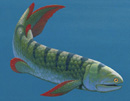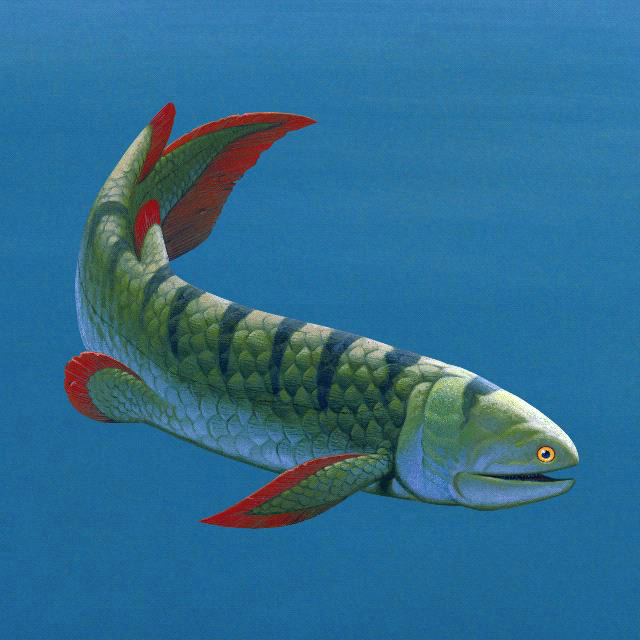Porolepiforms
Porolepiforms were very large marine predators that appeared at the beginning of the Devonian Period.
 (44 kb) They subsequently colonized brackish and fresh water environments, becoming quite common during the Upper Devonian. The fossil record, however, reveals few genera. Their distinctive scales are used as index fossils for the relative dating of rock layers.
(44 kb) They subsequently colonized brackish and fresh water environments, becoming quite common during the Upper Devonian. The fossil record, however, reveals few genera. Their distinctive scales are used as index fossils for the relative dating of rock layers.
Porolepiforms had long, tapered pectoral fins, a short, thick head and small eyes. As with the dipnoi, porolepiforms had lost their intracranial joint and the skull was a single unit. Their features, including a tail that could reach up to two metres long, lead some researchers to conclude that porolepiforms were ambush predators. Propulsion fins set far back on their bodies allowed for good acceleration, and their cranial morphology suggests strong musculature in the head region.
The similarity of the long, thin pectoral fin in porolepiforms and dipnoi, along with other features, has prompted specialists to place these two groups into a new, larger group: the dipnomorphs.
Of all the porolepiforms, the widespread genus Holoptychius is one of the best known. It is also the last genus of this group to be wiped out at the end of the Devonian. Although it both appeared and then disappeared during Devonian time, it nonetheless prospered for 50 million years. Two porolepiform species have been described at Miguasha, and a possible third species has not been yet described.

 (44 kb) They subsequently colonized brackish and fresh water environments, becoming quite common during the Upper Devonian. The fossil record, however, reveals few genera. Their distinctive scales are used as index fossils for the relative dating of rock layers.
(44 kb) They subsequently colonized brackish and fresh water environments, becoming quite common during the Upper Devonian. The fossil record, however, reveals few genera. Their distinctive scales are used as index fossils for the relative dating of rock layers.Porolepiforms had long, tapered pectoral fins, a short, thick head and small eyes. As with the dipnoi, porolepiforms had lost their intracranial joint and the skull was a single unit. Their features, including a tail that could reach up to two metres long, lead some researchers to conclude that porolepiforms were ambush predators. Propulsion fins set far back on their bodies allowed for good acceleration, and their cranial morphology suggests strong musculature in the head region.
The similarity of the long, thin pectoral fin in porolepiforms and dipnoi, along with other features, has prompted specialists to place these two groups into a new, larger group: the dipnomorphs.
Of all the porolepiforms, the widespread genus Holoptychius is one of the best known. It is also the last genus of this group to be wiped out at the end of the Devonian. Although it both appeared and then disappeared during Devonian time, it nonetheless prospered for 50 million years. Two porolepiform species have been described at Miguasha, and a possible third species has not been yet described.
Site map | Feedback | Links | Sources | Credits
Porolepiforms
<< Miguashaia | Holoptychius >>



